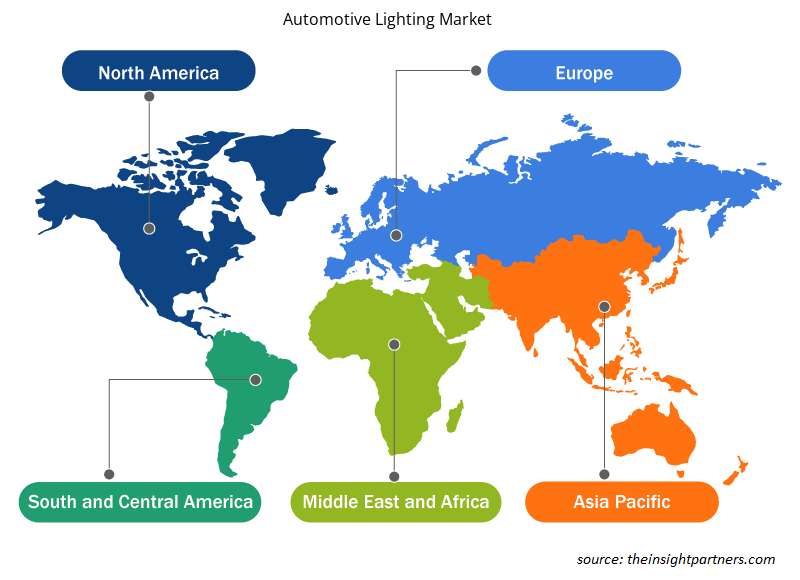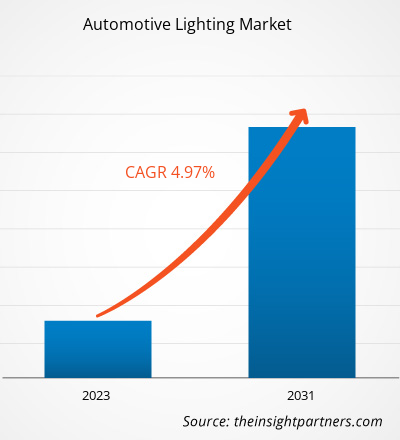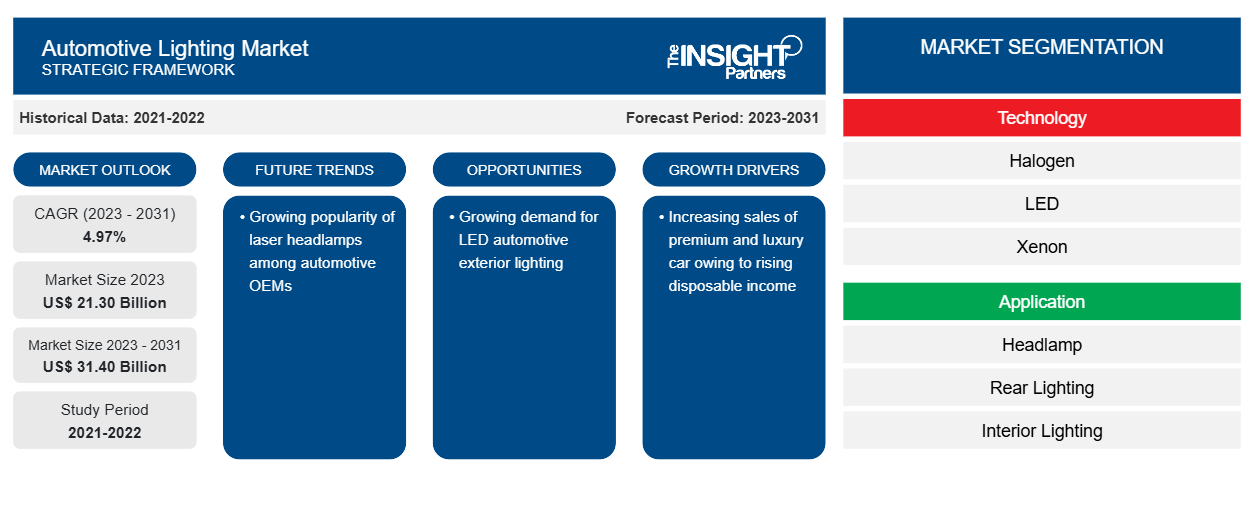Le marché de l'éclairage automobile devrait atteindre 31,40 milliards de dollars d'ici 2031, contre 21,30 milliards de dollars en 2023. Le marché devrait enregistrer un TCAC de 4,97 % entre 2023 et 2031. L'augmentation des ventes de voitures haut de gamme et de luxe stimule le marché de l'éclairage automobile et offre également des perspectives de croissance aux fournisseurs d'éclairage.
Analyse du marché de l'éclairage automobile
L'écosystème de l'éclairage automobile se compose des principaux acteurs suivants, à savoir : les fournisseurs de matières premières, les fabricants d'éclairage automobile/OEM et les utilisateurs finaux. Les fournisseurs de matières premières comprennent les fournisseurs qui fournissent des composants de matières premières clés pour l'éclairage automobile tels que le cuivre , l'aluminium, les LED et les diodes laser, entre autres. Les fabricants d'éclairage automobile/OES tels qu'Osram-Continental, Lumileds, Hella, Valeo et Automotive-Lighting, entre autres, intègrent et développent l'éclairage automobile pour différents types de véhicules. Les OEM automobiles partagent les phares, les feux arrière et les feux de signalisation spécifiques au véhicule avec les fournisseurs. Les fournisseurs proposent des devis uniques pour soumissionner pour l'accord du fournisseur. Le fournisseur sélectionné fournit ensuite les systèmes d'éclairage spécifiques au véhicule pendant toute la durée de l'accord d'appel d'offres. Les OEM intègrent ces composants d'éclairage dans leur véhicule final.
Aperçu du marché de l'éclairage automobile
Actuellement, les solutions d'éclairage matriciel à LED dominent l'ensemble des implémentations d'éclairage automobile. La technologie laser matricielle devrait encore améliorer l'éclairage de la route grâce à ses caractéristiques de haute résolution. La technologie laser matricielle est basée sur le LaserSpot pour les feux de route. Grâce à la technologie laser matricielle, il est devenu possible de faire converger la technologie du projecteur dans les phares des voitures particulières. Le facteur de luminance des lasers est environ cinq fois supérieur à celui des autres sources lumineuses disponibles sur le marché, et par conséquent, les phares laser offrent des portées de faisceau plus élevées aux conducteurs des véhicules. La portée du faisceau d'un phare laser typique dépasse 500 m. La BMW i8 et la BMW 7 sont les autres séries de voitures particulières équipées de phares intégrés au laser.
Personnalisez ce rapport en fonction de vos besoins
Vous bénéficierez d'une personnalisation gratuite de n'importe quel rapport, y compris de certaines parties de ce rapport, d'une analyse au niveau des pays, d'un pack de données Excel, ainsi que d'offres et de remises exceptionnelles pour les start-ups et les universités.
-
Obtenez les principales tendances clés du marché de ce rapport.Cet échantillon GRATUIT comprendra une analyse de données, allant des tendances du marché aux estimations et prévisions.
Facteurs moteurs et opportunités du marché de l'éclairage automobile
Augmentation des ventes de voitures haut de gamme et de luxe en raison de la hausse du revenu disponible
Dans les pays développés où les consommateurs disposent de revenus importants, on constate qu'avec l'augmentation du nombre de véhicules, les préférences des consommateurs en matière d'achat de voitures particulières diffèrent. Par conséquent, le coût et l'efficacité énergétique ne sont plus les principaux critères d'achat de ces voitures ; les achats dépendent plutôt du confort et du luxe qu'elles offrent. De plus, les consommateurs évaluent de plus en plus les systèmes d'éclairage et l'ergonomie des voitures lors de leur choix.
Demande croissante d'éclairage extérieur LED pour automobiles
Selon les données de la National Highway Traffic Safety Administration (NHTSA), bien que seulement 25 % du temps total de conduite des véhicules de tourisme soit de nuit, environ 50 % de tous les décès liés à des véhicules de tourisme surviennent dans l'obscurité. Cela est principalement dû à une visibilité et un éclairage inappropriés sur les routes, ainsi qu'à un éclairage insuffisant fourni par les phares des véhicules. Les préoccupations en matière de sécurité ont incité les constructeurs automobiles à rechercher une alternative plus sûre. Les feux antibrouillard LEDriving d'OSRAM sont remarquables en termes d'innovation, de design et de performances. De plus, Philips propose les technologies AirFlux et AirCool, qui aident à contrôler la chaleur produite par les feux antibrouillard LED. Il s'agit de systèmes de refroidissement intelligents qui évitent la chaleur du composant critique de la lumière, augmentant ainsi la résistance à la chaleur et prolongeant efficacement la durée de vie des LED.
Analyse de segmentation du rapport sur le marché de l'éclairage automobile
Les segments clés qui ont contribué à l’élaboration de l’analyse du marché de l’éclairage automobile sont la technologie, l’application et le type de véhicule.
- Sur la base de la technologie, le marché de l'éclairage automobile a été divisé en halogène, LED, xénon et laser. Le segment LED détenait une part de marché plus importante en 2023.
- En fonction des applications, le marché de l'éclairage automobile est segmenté en phares, éclairage arrière, éclairage intérieur, feux de croisement, feux antibrouillard et petites lampes. Le segment des phares détenait la plus grande part du marché en 2023.
- En fonction du type de véhicule, le marché de l'éclairage automobile a été divisé en voitures particulières, véhicules utilitaires légers et véhicules utilitaires légers et véhicules utilitaires lourds. Le segment des voitures particulières détenait une part de marché plus importante en 2023.
Analyse du marché de l'éclairage automobile par zone géographique
La portée géographique du rapport sur le marché de l’éclairage automobile est principalement divisée en cinq régions : Amérique du Nord, Europe, Asie-Pacifique, Moyen-Orient et Afrique et Amérique du Sud.
Français Le rapport sur le marché de l'éclairage automobile couvre l'Amérique du Nord (États-Unis, Canada et Mexique), l'Europe (Espagne, Royaume-Uni, Allemagne, France, Italie et reste de l'Europe), l'Asie-Pacifique (Corée du Sud, Chine, Inde, Japon, Australie et reste de l'Asie-Pacifique), le Moyen-Orient et l'Afrique (Afrique du Sud, Arabie saoudite, Émirats arabes unis et reste du Moyen-Orient et de l'Afrique) et l'Amérique du Sud et centrale (Brésil, Argentine et reste de l'Amérique du Sud et centrale). En termes de chiffre d'affaires, l'APAC a dominé la part de marché de l'éclairage automobile en 2023. L'Europe est le deuxième contributeur au marché mondial de l'éclairage automobile, suivie de l'Amérique du Nord.
Aperçu régional du marché de l'éclairage automobile
Les tendances régionales et les facteurs influençant le marché de l’éclairage automobile tout au long de la période de prévision ont été expliqués en détail par les analystes d’Insight Partners. Cette section traite également des segments et de la géographie du marché de l’éclairage automobile en Amérique du Nord, en Europe, en Asie-Pacifique, au Moyen-Orient et en Afrique, ainsi qu’en Amérique du Sud et en Amérique centrale.

- Obtenez les données régionales spécifiques au marché de l'éclairage automobile
Portée du rapport sur le marché de l'éclairage automobile
| Attribut de rapport | Détails |
|---|---|
| Taille du marché en 2023 | 21,30 milliards de dollars américains |
| Taille du marché d'ici 2031 | 31,40 milliards de dollars américains |
| Taux de croissance annuel composé mondial (2023-2031) | 4,97% |
| Données historiques | 2021-2022 |
| Période de prévision | 2023-2031 |
| Segments couverts |
Par technologie
|
| Régions et pays couverts |
Amérique du Nord
|
| Leaders du marché et profils d'entreprises clés |
|
Densité des acteurs du marché de l'éclairage automobile : comprendre son impact sur la dynamique commerciale
Le marché de l'éclairage automobile connaît une croissance rapide, tirée par la demande croissante des utilisateurs finaux en raison de facteurs tels que l'évolution des préférences des consommateurs, les avancées technologiques et une plus grande sensibilisation aux avantages du produit. À mesure que la demande augmente, les entreprises élargissent leurs offres, innovent pour répondre aux besoins des consommateurs et capitalisent sur les tendances émergentes, ce qui alimente davantage la croissance du marché.
La densité des acteurs du marché fait référence à la répartition des entreprises ou des sociétés opérant sur un marché ou un secteur particulier. Elle indique le nombre de concurrents (acteurs du marché) présents sur un marché donné par rapport à sa taille ou à sa valeur marchande totale.
Les principales entreprises opérant sur le marché de l'éclairage automobile sont :
- Éclairage automobile LLC
- Hella GmbH & Co. KGaA
- Société de fabrication Koito
- Ltd.
- Lumileds Holding BV
Avis de non-responsabilité : les sociétés répertoriées ci-dessus ne sont pas classées dans un ordre particulier.

- Obtenez un aperçu des principaux acteurs du marché de l'éclairage automobile
Actualités et développements récents du marché de l'éclairage automobile
Le marché de l'éclairage automobile est évalué en collectant des données qualitatives et quantitatives après des recherches primaires et secondaires, qui comprennent d'importantes publications d'entreprise, des données d'association et des bases de données. Voici une liste des développements sur le marché de l'éclairage automobile et des stratégies :
- En juillet 2023, Marelli, en collaboration avec ams OSRAM, lance une innovation révolutionnaire dans le domaine de l'éclairage avant automobile, en introduisant le module microLED h-Digi®, qui est désormais en production en série. Cette solution d'éclairage numérique, basée sur un nouveau type de LED multipixel intelligente, permet un fonctionnement entièrement adaptatif et dynamique des phares et une projection d'images, tout en étant une technologie abordable, disponible pour une plus large gamme de véhicules. (Source : Marelli, communiqué de presse/site Web de l'entreprise/bulletin d'information)
- En décembre 2023, OLEDWorks a annoncé qu'elle présenterait la dernière technologie d'éclairage OLED pour l'industrie automobile et redéfinirait le paysage avec le lancement d'une nouvelle marque passionnante au CES 2024. L'équipe OLEDWorks, composée d'experts techniques OLED et de stratèges en solutions clients, attend avec impatience d'accueillir les participants au stand n° 3225 dans le West Hall du Las Vegas Convention Center, où ils pourront découvrir les innovations de pointe qui façonneront l'avenir de l'éclairage automobile. (Source : OLEDWorks, communiqué de presse/site Web de l'entreprise/bulletin d'information)
Rapport sur le marché de l'éclairage automobile : couverture et livrables
Le rapport « Taille et prévisions du marché de l’éclairage automobile (2021-2031) » fournit une analyse détaillée du marché couvrant les domaines ci-dessous :
- Taille du marché et prévisions aux niveaux mondial, régional et national pour tous les segments de marché clés couverts par le périmètre
- Dynamique du marché, comme les facteurs moteurs, les contraintes et les opportunités clés
- Principales tendances futures
- Analyse détaillée des cinq forces de Porter
- Analyse du marché mondial et régional couvrant les principales tendances du marché, les principaux acteurs, les réglementations et les développements récents du marché
- Analyse du paysage industriel et de la concurrence couvrant la concentration du marché, l'analyse de la carte thermique, les principaux acteurs et les développements récents
- Profils d'entreprise détaillés avec analyse SWOT
- Analyse historique (2 ans), année de base, prévision (7 ans) avec TCAC
- Analyse PEST et SWOT
- Taille du marché Valeur / Volume - Mondial, Régional, Pays
- Industrie et paysage concurrentiel
- Ensemble de données Excel
Rapports récents
Témoignages
Raison d'acheter
- Prise de décision éclairée
- Compréhension de la dynamique du marché
- Analyse concurrentielle
- Connaissances clients
- Prévisions de marché
- Atténuation des risques
- Planification stratégique
- Justification des investissements
- Identification des marchés émergents
- Amélioration des stratégies marketing
- Amélioration de l'efficacité opérationnelle
- Alignement sur les tendances réglementaires























 Obtenez un échantillon gratuit pour - Marché de l'éclairage automobile
Obtenez un échantillon gratuit pour - Marché de l'éclairage automobile